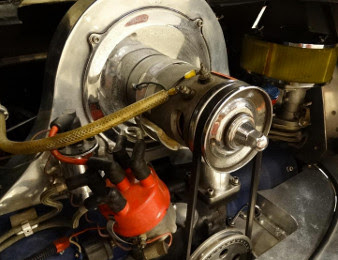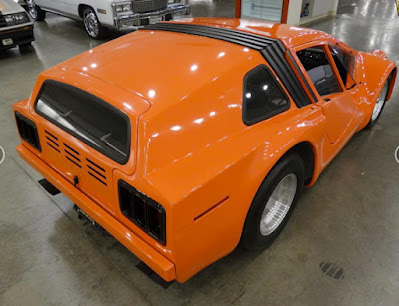💣Forgotten BEAST💣 - The end of the V12 engine era is imminent, a reality that car enthusiasts are slowly coming to terms with. Despite the incredible engineering behind 12-cylinder powerplants, they struggle to compete with electric motors' instant torque and silent operation. Even Ferrari's new 'piccolo V12,' a 2.9-litre V6 engine in the 296 GTB, is receiving accolades instead of criticism. The charm of the V12 is now more evident than ever, a sentiment heightened by the rarity of new V12 models like the upcoming Aventador. The automotive world is seeing fewer of these magnificent engines, making the ones still available all the more special.
 |
| The Lister Jaguar XJ-S 'Le Mans' emerged in 1989 after six years of development, embodying the raw power and sophistication that make V12 engines so revered, while boasting a proper manual transmission, widebody kit, and impressive wheels. (Picture from: RoadAndTrack) |
One of the most impressive V12 engines ever installed in a production car can be found in the 1985 Jaguar XJ-S. This engine is larger than those in any Lamborghini, Ferrari, or even the McLaren F1. The only engine that rivals its size is the V12 in the Pagani Zonda. For aficionados of twelve-cylinder engines, the 1985 Jaguar XJ-S is a dream come true, embodying the raw power and sophistication that makes V12 engines so revered.
 |
| With only 20 units produced, the Lister Jaguar XJ-S 'Le Mans' was a rare gem in the automotive world, debuting just before the firm introduced its legendary Storm race car. (Picture from: ShmooAutomotive) |
Lister is a name synonymous with excellence in sports car racing history. The Lister-Jaguar, designed by Brian Lister, dominated its first full racing season in 1957. In the following decades, Lister cars became a force in GT racing worldwide. By the early 1980s, Lister expanded its legacy to road cars, with highly modified XJ-S models marketed as Lister-Jaguars, thanks to agreements with BLE Automotive and WP Automotive.
 |
| The Lister Jaguar XJ-S 'Le Mans' featured a wider track, 17-inch Lister-branded alloy wheels under flared fenders, and wider bumpers for a refined look. (Picture from: PistoHeads) |
The culmination of Lister's efforts occurred in 1989 after six years of development. Dubbed the Lister Le Mans, it featured a bored-out version of the XJS V12 engine paired with not one but two superchargers. The car also boasted a widebody kit, an impressive set of wheels, and a proper manual transmission.
This was not merely a modified XJ-S but a thoroughly re-engineered supercar. The only original parts retained were the doors, windscreen glass, front suspension uprights, wishbones, and alternator. With only 20 units produced, the Lister Le Mans was a rare gem in the automotive world, debuting just before the firm introduced its legendary Storm race car.
 |
| Inside, the Lister Jaguar XJ-S 'Le Mans' features a luxurious Lister Recaro leather interior. (Picture from: PistoHeads) |
The Lister Le Mans featured a wider track, 17-inch Lister-branded alloy wheels under flared fenders, and wider bumpers for a refined look. It also boasted a new suspension setup and AP Racing brakes on all four corners, ensuring superb handling and stopping power. The car was named to celebrate Jaguar's success at the Le Mans race in the late 1980s, transforming the Jaguar XJ-S into a 200 mph supercar.
Under the hood, the Lister Le Mans housed a 7.0-litre version of Jaguar's V12 engine, reworked to produce 604 bhp and a similar torque figure, ensuring breathtaking acceleration in any gear. The suspension, brakes, wheels, and tires were all upgraded to handle the immense power, while a sleek body kit maintained stability at high speeds.
 |
| The Lister Jaguar XJ-S 'Le Mans,' powered by a reworked 7.0-litre V12 engine producing 604 bhp, accelerates from 0-100 km/h in just 4.5 seconds. (Picture from: PistoHeads) |
The basic XJ-S body underwent extensive modifications, including large alloy wheels, restyled rear buttresses, and a variety of ground-hugging skirts and spoilers. Inside, the car featured a luxurious Lister Recaro leather interior.
For those who found the standard V12 Jaguar engine lacking, Lister offered a comprehensive tuning package. This included modified fuel injection with additional injectors and throttle bodies, a tweaked engine management system, gas-flowed heads with larger valves, and a nitrided crankshaft. Cosworth conrods and special forged pistons were used, along with new bearings and a modified oil system, to reliably deliver 604 bhp.
 |
| The
Lister Jaguar XJ-S 'Le Mans' was not merely a modified XJ-S but a thoroughly re-engineered supercar. (Picture from: ShmooAutomotive) |
 |
| The Lister Jaguar XJ-S 'Le Mans' was built on the basic XJ-S body, which underwent extensive modifications, including large alloy wheels, restyled rear buttresses, and various ground-hugging skirts and spoilers. (Picture from: ShmooAutomotive) |
As the automotive industry shifts towards more environmentally friendly technologies, the V12 engine's days are numbered. However, the legacy of these powerful machines lives on in the memories of enthusiasts and the history of remarkable cars like the Lister Le Mans. This era of automotive excellence may be ending, but its impact will be remembered for generations to come.
 |
| The Lister Jaguar XJ-S 'Le Mans' stood as a testament to the brilliance of V12 engineering and the dedication of those who sought to push automotive boundaries. (Picture from: PistoHeads) |
In this ever-evolving landscape of automotive technology, the V12 engine remains a symbol of an era defined by power, innovation, and passion. The transition to electric and more efficient engines is inevitable, but the legacy of the V12 will continue to inspire and captivate those who appreciate the artistry of automotive engineering.
 As we look forward to new advancements, the story of the V12 will always hold a special place in the hearts of car enthusiasts. The grandeur of the V12 era, marked by remarkable cars like the Lister Le Mans, ensures its spirit will endure even as the automotive world transforms. *** [EKA | FROM VARIOUS SOURCES | LISTER | PISTONHEADS | ROADANDTRACK | CLASSICINSIDER | BONHAMS | SHMOOAUTOMOTIVE | DIECASTXCHANGE ]
As we look forward to new advancements, the story of the V12 will always hold a special place in the hearts of car enthusiasts. The grandeur of the V12 era, marked by remarkable cars like the Lister Le Mans, ensures its spirit will endure even as the automotive world transforms. *** [EKA | FROM VARIOUS SOURCES | LISTER | PISTONHEADS | ROADANDTRACK | CLASSICINSIDER | BONHAMS | SHMOOAUTOMOTIVE | DIECASTXCHANGE ]Note: This blog can be accessed via your smart phone



































